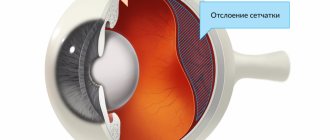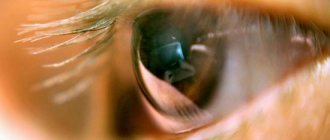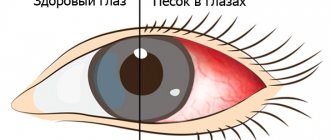Throughout life, a person experiences visual impairment.
Black spots and spots may appear before the eyes.
They can swim or fly, appear at the point of vision fixation.
Such manifestations can be temporary or bother a person permanently. Age does not affect such occurrences. In most cases, this is not a sign of serious illness. But sometimes black spots before the eyes may indicate the development of ophthalmic diseases.
Symptoms
Symptoms are usually based on the patient's own feelings. Patients may experience minor, small floaters or bulky spots. People who have encountered such defects complain of the appearance of blackheads that linger when they turn their heads. Doctors explain this manifestation by the presence of interference with the fluid that fills the vitreous body.
With such interference, severe pathologies can occur. Flashes may appear against the background of such points. The number of such spots depends on the extent of the disease and the age of the victim. In some cases, the spots may be single. The patient can easily see each spot. Sometimes they can appear as large spots that significantly affect the clarity of vision. This limits a person’s ability to work and prevents them from leading a normal lifestyle. In addition, accompanying symptoms may appear:
- dizziness;
- headache;
- numbness of the limbs;
- accelerated heartbeat;
- feeling of panic;
- decreased concentration;
- high blood pressure;
- rapid pulse;
- nausea;
- migraine.
These symptoms may indicate disorders of the central nervous system. Often such signs are accompanied by vegetative-vascular dystonia.
The patient sees flashes against a background of black spots. Sometimes you may experience fainting, severe fatigue and weakness. In such cases, the patient will need bed rest at rest.
Nature of appearance
On a sunny day, or when reading books or viewing documents, you can see flying threads and little bodies, they are especially visible against a light, bright background. They do not cause any physical anxiety or pain, but they put quite a lot of pressure on the moral state, so, out of ignorance, someone who is faced with this unusual phenomenon can come up with many incorrect diagnoses.
You should not rush to see an ophthalmologist if you experience such a phenomenon very rarely or if it happened for the first time. However, you can start sounding the alarm when this disease appears regularly or causes you some inconvenience.
This disease, flies, threads or fibers indicate some malfunction in the internal gel substance, which is located between the lens and the retina - it is called the vitreous body. Therefore, when it seems to us that we see these midges, but this is a shadow reflection, this is the work of the visual system.
By the way, until the age of 40, we should, as usual, see strings and dots of a transparent color. Changes indicate the possible onset of the disease, with developing pathology, the penetration of frozen clots into a gel-like substance, or the presence of dead cells in the vitreous body.
Causes
There are a large number of factors that cause such phenomena. In most cases, patients experience this in adulthood and old age. This is affected by age-related depletion of the body. There are also reasons that cause destruction in young people and children.
Common reasons include:
- eye injuries;
- traumatic brain injuries;
- hemorrhages in the eyes;
- spasms;
- pathological changes in the structure of blood vessels;
- infectious eye diseases;
- deficiency of minerals and vitamins in the body;
- excessive physical activity;
- emotional stress;
- prolonged eye strain;
- consequences after surgery;
- smoking;
- alcohol and drug abuse.
In each patient, the doctor discovers specific reasons that led to destruction. Taking these factors into account, the treatment method is determined.
Association with diseases
It is worth noting that the vitreous body can independently undergo destructive changes. Then doctors do not look for the reasons that provoked black spots before the eyes. But sometimes such symptoms may indicate other pathologies:
- intoxication due to exposure to chemicals;
- diabetes;
- presence of neoplasms;
- retinal detachment;
- fungal infections;
- viral diseases;
- hemorrhages;
- CNS disorders;
- vegetative-vascular dystonia;
- circulatory disorders.
Attacks of vegetative-vascular dystonia are often accompanied by the appearance of black spots before the eyes. They mostly appear as large spots. The patient almost completely loses visual acuity for a short time. In addition to bright flashes, the upper eyelid may twitch, and objects in front of the eyes may blur.
This is accompanied by severe sensitivity to light. The patient develops fear, anxiety and panic. To this day, the pathology does not have a specific treatment regimen. Therefore, the use of complex therapy and examination by several specialized specialists is required.
In order for floating spots to disappear, all diseases must be cured initially. After this, such defects will disappear on their own. To identify such diseases, careful diagnosis will be required. After the results, the doctor prescribes drug therapy.
Therapy
When there are spots in the eyes, the causes need to be given special importance. It is important to determine what led to their appearance, and only then begin therapy. To make an accurate diagnosis, the doctor may prescribe an examination. Usually, to examine the condition of the eyes, it is enough to check them with a special device, but sometimes additional checks are required using a biopsy, CT, MRI, ultrasound, ECG and standard tests. Having determined the root cause, the doctor will be able to prescribe the correct therapeutic measures.
If the eyes were previously injured, which caused the development of defects, then the patient is prescribed healing agents. “Korneregel” and “Solcoseryl” are considered the most effective. For infections, Normax or Oftalmoferon may be prescribed. For other underlying causes not directly related to the eyes, treatment will be carried out not only by an ophthalmologist, but also by a doctor from another field responsible for the identified disease. Only joint efforts will help completely solve the problem and avoid its reoccurrence.
In some cases, surgery may be required. It is usually necessary when the stains are caused by the vitreous humor. The only way to get rid of the problem is to remove it. The remaining space will be filled with a special solution that maintains the shape of the eye. After some time, the body independently forms a new vitreous body, which will fully function.
Sometimes cloudy spots in the eyes are removed using laser correction. The specialist directs a special beam to the problem area, destroying the foreign formation. The result is a reduction or complete elimination of the stain. This technique is used quite rarely, as it is considered experimental. Sometimes it does not give any effect at all or brings minimal results, which sometimes becomes the reason for refusing to use it.
Standard treatment can be supplemented with folk remedies. They may be contraindicated in some diseases, so you should consult your doctor in advance.
Three folk remedies:
- Eyebright decoction. Pour boiling water (1 l) over the herb (3 tablespoons), leave for a couple of hours inside a closed container. After straining, drink a glass three times a day.
- Aloe drops. Squeeze the juice from the plant, mix with water 1 to 1. Using a pipette, drop into the eyes twice every day.
- Herbal mixture. Pour boiling water (2 liters) over chamomile, calendula and plantain (3 tablespoons each) for a couple of hours. Dip your face into the strained liquid, open your eyes and roll them.
When using the latter method, caution should be exercised, as poor straining may leave plant particles in the water. Careless actions can easily lead to further eye damage. But the method itself is considered very effective if a small dark floating spot appears in the eye. Therefore, it is not worth abandoning it completely.
Sometimes treatment has to be carried out even after the stain has been eliminated.
Black spots in the eyes
The appearance of black spots in the eyes is associated with exposure to sunlight. Recently, doctors have noted that people who do not protect their eyes from the sun are experiencing changes in their eyes. There is currently no scientific evidence of the effects of the sun on the eyes. But doctors have already identified a biomarker - small black dots on the iris. The main reason is strong exposure to sunlight.
In rare cases, such phenomena are congenital. It is also worth noting that with age, black spots in the eyes may disappear on their own. This phenomenon is under study, since scientists have not established the true cause of such defects.
Diagnostics
To diagnose such defects, a thorough examination of the entire body will be required. Basically, doctors prescribe the following diagnostic methods:
- ophthalmoscopy – used for a thorough examination of the eyes;
- MRI of the brain and spine;
- general blood test, urine test;
- X-ray;
- ultrasound examinations of internal organs;
- blood test for sugar levels.
After a thorough examination, the doctor can determine the cause of such phenomena. Taking into account the factors, treatment is prescribed. It is worth noting that in childhood it is much more difficult to diagnose. Young children cannot talk about what worries them. Children rarely experience such phenomena. To exclude serious diseases, it is necessary to undergo timely examinations by a pediatrician and ophthalmologist. If visual impairment is observed, you should immediately consult a doctor. This will help to detect the presence of pathological processes in time.
What spots on the eyeballs tell you: types, diseases and treatment
A person's eyes reflect the general condition of the body. With the development of any disease, you can observe the appearance of spots on the eyeballs. Their color, shape, and time of appearance serve as diagnostic signs, on the basis of which the doctor suspects a disease.
Congenital spots
In humans, spots on the cornea of the eye can be detected immediately after birth. Their appearance is associated with a congenital disorder in the production of melanin pigment. The spots are called nevi; they are black or brown in color and are located on the sclera.
If a birthmark has formed in the eye, you should consult an ophthalmologist. The spots tend to grow, causing vision impairment. Pigment formations can degenerate into malignant ones. This happens quite rarely, but pathology must be excluded.
A child sometimes develops darkening of the iris. This is how iris tumors manifest themselves - benign or malignant. Urgent consultation with an ophthalmologist is recommended.
Spots on the retina of the eye can only be detected when examined with a special device - a slit lamp. They develop due to impaired blood supply - with hypertension, diabetes.
Acquired spots
If dots appear in the eyes throughout life, the reasons for this may be different conditions. These are not necessarily diseases - spots are the result of overwork or the use of medications.
Reds
The appearance of red spots is usually associated with the reaction of blood vessels:
- eye injury with capillary damage;
- a sharp increase in pressure leading to rupture of the vessel;
- an inflammatory process accompanied by capillary swelling.
They appear suddenly and disappear within a few days. They rarely stay for a long time.
Yellow
Associated with the accumulation of cholesterol in the eyes. Yellow spots are called xanthomas and xanthelasmas. Often observed in older people and patients with diabetes.
White
They represent a clouding of the cornea, called a cataract or leukoma. Formed due to damage to the cornea of the eye:
- keratitis of various origins - viral, bacterial. traumatic;
- postoperative or post-traumatic scar;
- chemical burn.
They have different sizes, and when they spread to the pupil area, they lead to deterioration of vision. They appear in one eye but can spread to the other.
External
Such spots are not associated with pigmentation of the cornea or sclera:
- pterygium - is an overgrown area of the conjunctiva, creeping onto the cornea, contains blood vessels, impairs vision;
- pinguecula - a spot or small pimple in the area of the junction of the conjunctiva and sclera, occurs with excessive exposure to ultraviolet radiation.
These pathologies tend to progress rapidly, so urgent consultation with a doctor is recommended.
Dark or black spots
A dark spot on the cornea of the eyeball appears due to macular degeneration. It is associated with impaired blood supply to the vitreous body. The causes are usually bad habits and age-related changes in the body.
The disease is accompanied by decreased vision and pain. Dark areas gradually increase in size, indicating the progression of the disease. Lack of treatment leads to irreversible blindness.
Brown and black spots on the whites of the eyes occur against the background of impaired pigment metabolism. Melanocytes begin to intensively secrete melanin, which forms black spots on the eyes. It is observed in hereditary diseases and oncological pathologies.
Quite rarely, black dots on the whites of the eyes are formed due to a fungal infection. Aspergillus spores, a microscopic fungus, can enter the eyeball. There they grow, causing pain and blurred vision. It is extremely rare that the eye is affected by helminths - Toxocara or tropical parasites.
A dark spot on a child's eye is usually not a disease. This is a physiological process associated with a change in the color of the iris. The condition goes away with age.
If a black dot appears in the eye near the pupil, the person may have had an eye injury with damage to the iris. Its pupillary edge is torn, causing the pupil to lose its round shape.
Gray spots
Gray spots on the whites of the eyes appear for the same reasons as dark spots. This change in the color of the sclera may be due to a low-pigment nevus. Less often, protein acquires this color if a person works with coal. Dust eats into all areas of the skin and mucous membranes.
Treatment
To prescribe treatment, the doctor needs to determine why colored or black dots appeared near the pupil, on the sclera.
- For injuries, surgery is used. After this, healing drugs are prescribed - “Korneregel”, “Solcoseryl”.
- Infectious diseases are treated with drops or ointments. Antibacterial - “Normax”, “Uniflox”. Antiviral - “Ophthalmoferon”.
- In case of pigmented formations, pterygium, pinguecula, the issue of their removal is decided. To prevent relapses, vitamin preparations are prescribed - “Taufon”, “Pro-vizio”.
Children are first placed under observation. In most babies, the spots disappear on their own.
Self-treatment and the use of folk remedies are not recommended. Without consulting a doctor, you can miss a serious illness and permanently lose your vision.
Spots on the eyeball are a sign of a malfunction of the body. It is recommended to consult a doctor to identify the cause of the pathology. After this, appropriate treatment is prescribed.
Share the article on social networks, leave comments describing your experience. Be healthy.
Source: https://ozrenieglaz.ru/simptomy/pyatna-na-glaznom-yabloke
How to get rid of black dots before eyes
When a person notices that a black dot is floating in front of his eye, he should consult a doctor. Self-medication can cause severe complications. Such phenomena are not a specific disease or pathology. Black goose bumps are a sign of a specific disease that requires treatment.
If such phenomena appear periodically, the doctor may prescribe eye drops, for example, Taufon, Quinax.
Drops well stimulate the function of metabolic processes in the vitreous body. If neoplasms have arisen in it, which have caused the appearance of a few black spots, then the drops will affect their resorption. If drug therapy does not give the desired result, then treatment is carried out using the following methods:
- Vitreolysis. The procedure is performed using a laser, which eliminates tumors in the vitreous body.
- Vitrectomy. This is an operation that is performed to partially or completely remove the vitreous. This method is mainly used to treat irreversible processes.
If there are a lot of black spots in the eyes, then the patient suffers from severe discomfort. They affect the decrease in visual acuity. A person cannot continue any work activity. Therefore, at the first manifestations, you should consult a doctor. Timely diagnosis increases the chances of a favorable treatment outcome. It is worth noting that such symptoms do not disappear on their own.
Treatment
If the points in front of the eyes significantly impair visual acuity and interfere with the viewing of most objects, surgical operation is recommended:
- Vitrectomy. During the operation, all fluid from the vitreous body is removed from the patient and replaced with a new, but artificial one. Its consistency is similar to natural components and also conducts light rays. After the operation, visual acuity does not decrease. The operation is quite radical, so doctors use it as a last resort if a person severely loses vision due to black spots in front of the eyes.
- Vitreolysis. Laser surgery, with the help of which large formations inside the vitreous, leading to the appearance of spots before the eyes, are crushed into small elements. Their size is so small that they cannot be seen with human eyes. The operation is expensive and is not applicable to large elements of the vitreous.
If the patient’s condition is not radical, visual acuity remains, dots appear before the eyes periodically, the doctor will recommend the use of conservative therapy. Medicinal drops are used that normalize metabolism inside the eyeballs. This promotes tissue regeneration and the elimination of temporary formations inside the vitreous (dots, spots, stripes) that cast a shadow on the retina.
Treatment of the underlying disease that causes the disorder is also used:
- adjusting insulin dosage for diabetes mellitus;
- drugs that reduce intraocular and blood pressure;
- medications that reduce the number of atherosclerotic plaques and cholesterol in the blood;
- removal of a foreign body in the eye;
- antibacterial, antiviral, antifungal therapy.
Treatment must be comprehensive. Several medications are used to reduce the risk of disease recurrence and complications.
Prevention
Preventive measures are mainly aimed at supporting the health of the entire body. When a black dot runs before your eyes, this is a sign of a certain disease. It can be ophthalmological, endocrine, chronic. In case of eye injuries and burns, such manifestations disappear after complete recovery. It is important to monitor your health to reduce the risk of developing any pathologies. Basic recommendations:
- daily walks in the fresh air;
- healthy lifestyle;
- complete and balanced nutrition;
- giving up bad habits - smoking, drinking alcohol and drugs;
- consuming enough vitamin A;
- full, healthy sleep;
- timely visit to an ophthalmologist;
- examination of the body every six months.
It is worth noting that sleep should last 7-8 hours. Only during this period the eyes have the opportunity to completely relax and rest. This is especially important when working at a computer for a long time and excessive strain on the eyes. When tired, a person can observe how the black dot moves. Such symptoms may disappear after proper rest. For eye health, the body must have a sufficient amount of vitamin A. It is found in carrots and blueberries. The condition of the body must be monitored from childhood. Then the risk of developing diseases will be insignificant.











